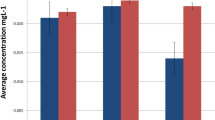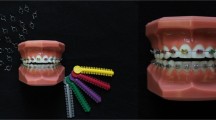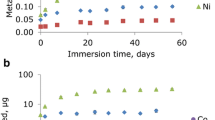Abstract
The paper discusses various approaches used to investigate biocompatibility by the analysis of metals release by the materials of which orthodontic appliances are made. Analysis of various biomarkers of exposure: saliva, serum, mucosa cells, or urine is used in in vivo tests. In this work, the techniques, results, and conclusions of original papers were compared by the implementation of the concept of a systematic review. The aim of the present work was to report the state-of-the-art in the research on methods used to assess exposure to trace metals from orthodontic appliances. The PubMed search identified 35 studies, among which nine met the selection criteria. The general conclusion in the studies was that metal ions were released mostly in the initial stage of the treatment. However, the majority of studies included 1–2 months long period and did not reflect long-term changes nor the impact of the complete treatment, the duration of which is several years, on the whole organism and the overall accumulation of metals from orthodontic appliances. In studies which evaluated nickel concentrations in blood and urine, long-term metal release was detected and significant differences were found. It leads to the conclusion that nickel ions are released from orthodontic appliances in measurable amounts to human organism.
Similar content being viewed by others
References
Turpin DL (2005) CONSORT and QUOROM guidelines for reporting randomized clinical trials and systematic reviews. Am J Orthod Dentofacial Orthop 125:681–686
Richard A, Brand MD (2009) Standards of reporting: the CONSORT, QUOROM, and STROBE guidelines. Clin Orthop Relat Res 467:1393–1394
Moher D, Cook DJ, Eastwood S et al (1999) Improving the quality of reports of meta-analyses of randomized controlled trials: the QUOROM statement. Lancet 354:1896–1900
Eliades T, Athanasiou AE (2002) In vivo aging of orthodontic alloys: implications for corrosion potential, nickel release, and biocompatibility. Angle Orthod 72:222–237
Kerosuo H, Moe G, Kleven E (1995) In vitro release of nickel and chromium from different types of simulated orthodontic appliances. Angle Orthod 65:111–116
Blanco-Dalmau L, Carrasquillo-Alberty H, Silva-Parra J (1984) A study of nickel allergy. J Prosthet Dent 52:116–119
Eliades T, Pratsinis H, Kletsas D, Eliades G, Makou M (2004) Characterization and cytotoxicity of ions released from stainless steel and nickel-titanium orthodontic alloys. Am J Orthod Dentofacial Orthop 125:24–29
Genelhu M, Marigo M, Alves-Oliveira LF, Malaquias L, Gomez RS (2005) Characterization of nickel-induced allergic contact stomatitis associated with fixed orthodontic appliances. Am J Orthod Dentofacial Orthop 128:378–381
Hayes RB (1997) The carcinogenicity of metals in humans. Cancer Causes Control 8:371–385
Faccioni F, Franceschetti P, Cerpelloni M, Fracasso ME (2003) In vivo study on metal release from fixed orthodontic appliances and DNA damage in oral mucosa cells. Am J Orthod Dentofacial Orthop 124:687–694
Petoumeno E, Kislyuk M, Hoederath H et al (2008) Corrosion susceptibility and nickel release of nickel titanium wires during clinical application. J Orofac Orthop 69(6):411–423
Eliades T, Trapalis C, Eliades G, Katsavrias E (2003) Salivary metal levels of orthodontic patients: a novel methodological and analytical approach. Eur J Orthod 25:103–106
Amini F, Borzabadi Farahani A, Jafari A, Rabbani M (2008) In vivo study of metal content of oral mucosa cells in patients with and without fixed orthodontic appliances. Orthod Craniofac Res 11(1):51–56
Matos de Souza R, Macedo de Menezes L (2008) Nickel, chromium and iron levels in the saliva of patients with simulated fixed orthodontic appliances. Angle Orthod 78(2):345–350
Ağaoğlu G, Arun T, Izgi B, Yarat A (2001) Nickel and chromium levels in the saliva and serum of patients with fixed orthodontic appliances. Angle Orthod 71(5):375–379
Kerosuo H, Moe G, Hensten-Pettersen A (1997) Salivary nickel and chromium in subjects with different types of fixed orthodontic appliances. Am J Orthod Dentofacial Orthop 111(6):595–598
Kocadereli L, Ataç PA, Kale PS, Ozer D (2000) Salivary nickel and chromium in patients with fixed orthodontic appliances. Angle Orthod 70(6):431–434
Menezes LM, Quintão CA, Bolognese AM (2007) Urinary excretion levels of nickel in orthodontic patients. Am J Orthod Dentofacial Orthop 131(5):635–638
Guidelines for Drinking-water Quality (2008) Third edition incorporating the first and second addenda. World Health Organization, Geneva
Fors R, Persson M (2006) Nickel in dental plaque and saliva in patients with and without orthodontic appliances. Eur J Orthod 28:292–297
Fairbrother A, Wenstel R, Sappington K, Wood W (2007) Framework for metals risk assessment. Ecotoxicol Environ Saf 68:145–227
Stadlbauer C, Reiter C, Patzak B, Stingeder G, Prohaska T (2007) History of individuals of the 18th/19th centuries stored in bones, teeth, and hair analyzed by LA-ICP-MS—a step in attempts to confirm the authenticity of Mozart's skull. Anal Bioanal Chem 388:593–602
Rodrigues JL, Batista BL, Nunes JA, Passos CJS, Barbosa F Jr (2008) Evaluation of the use of human hair for biomonitoring the deficiency of essential and exposure to toxic elements. Sci Total Environ 405:370–376
Moreda-Pineiro J, Alonso-Rodrigues E, Lopez-Mahia P et al (2007) Determination of major and trace elements in human scalp hair by pressurized-liquid extraction with acetic acid and inductively coupled plasma-optical emission spectrometry. Anal Bioanal Chem 388:441–449
Sfondrini MF, Cacciafesta V, Elena Maffia E, Massironi S, Scribante A, Alberti G, Raffaela Biesuz R, Klersy C (2008) Chromium release from new stainless steel, recycled and nickel-free orthodontic brackets. Angle Orthod 79:361–367
Cortizo MC, Fernández M, De Mele L, Cortizo AM (2004) Metallic dental material biocompatibility in osteoblastlike cells correlation with metal ion release. Biol Trace Elem Res 100:151–168
Hol PJ, Vamnes JS, Gjerdet NR et al (2002) Dental amalgam affects urinary selenium excretion. Biol Trace Elem Res 85:137–147
Toro E, de Goeij JJM, Bacso J et al (1993) The significance of hair mineral analysis as a means for assessing internal body burdens of environmental pollutants: results from an IAEA co-ordinated research programme. J Radioanal Chem 167(2):413–421
Further Reading
Baldwin PD, Pender N, Last KS (1999) Effects on tooth movement of force delivery from nickel-titanium archwires. Eur J Orthod 21(5):481–489
Cortizo MC, De Mele MF, Cortizo AM (2004) Metallic dental material biocompatibility in osteoblastlike cells: correlation with metal ion release. Biol Trace Elem Res 100(2):151–168
Elayyan F, Silikas N, Bearn D (2008) Ex vivo surface and mechanical properties of coated orthodontic archwires. Eur J Orthod 30(6):661–667
Eliades T, Zinelis S, Eliades G, Athanasiou AE (2002) Nickel content of as-received, retrieved, and recycled stainless steel brackets. Am J Orthod Dentofacial Orthop 122(2):217–220
Eliades T, Eliades G, Watts DC (2001) Intraoral aging of the inner headgear component: a potential biocompatibility concern? Am J Orthod Dentofacial Orthop 119(3):300–306
Eliades T, Eliades G, Athanasiou AE, Bradley TG (2000) Surface characterization of retrieved NiTi orthodontic archwires. Eur J Orthod 22(3):317–326
Evans TJ, Jones ML, Newcombe RG (1998) Clinical comparison and performance perspective of three aligning arch wires. Am J Orthod Dentofacial Orthop 114(1):32–39
Fricker JP (1998) A new self-curing resin-modified glass-ionomer cement for the direct bonding of orthodontic brackets in vivo. Am J Orthod Dentofacial Orthop 113(4):384–386
Grimsdottir MR, Hensten-Pettersen A (1997) Surface analysis of nickel-titanium archwire used in vivo. Dent Mater 13(3):163–167
Grosgogeat B, Pernier C, Schiff N et al (2003) Biocompatibility and resistance to corrosion of orthodontic wires. Orthod Fr 74(1):115–121
Ho KS, West VC (1991) Friction resistance between edgewise brackets and archwires. Aust Orthod J 12(2):95–99
Iijima M, Brantley WA, Kawashima I (2004) Micro-X-ray diffraction observation of nickel-titanium orthodontic wires in simulated oral environment. Biomaterials 25(1):171–176
Kapila S, Haugen JW, Watanabe LG (1992) Load-deflection characteristics of nickel-titanium alloy wires after clinical recycling and dry heat sterilization. Am J Orthod Dentofacial Orthop 102(2):120–126
Kebsch M, Wilkinson M, Petocz P, Darendeliler MA (2007) The effect of fluoride administration on rat serum osteocalcin expression during orthodontic movement. Am J Orthod Dentofacial Orthop 131(4):515–524
Lee KJ, Park YC, Yu HS, Choi SH, Yoo YJ (2004) Effects of continuous and interrupted orthodontic force on interleukin-1beta and prostaglandin E2 production in gingival crevicular fluid. Am J Orthod Dentofacial Orthop 125(2):168–177
Linder-Aronson A, Forsberg CM, Rygh P, Lindskog S (1996) Tissue response to space closure in monkeys: a comparison of orthodontic magnets and superelastic coil springs. Eur J Orthod 18(6):581–588
Pandis N, Christensen L, Eliades T (2005) Long-term clinical failure rate of molar tubes bonded with a self-etching primer. Angle Orthod 75(6):1000–1002
Ramalingam A, Kailasam V, Padmanabhan S, Chitharanjan A (2008) The effect of topical fluoride agents on the physical and mechanical properties of NiTi and copper NiTi archwires. An in vivo study. Aust Orthod J 24(1):26–31
Rix D, Foley TF, Banting D, Mamandras A (2001) A comparison of fluoride release by resin-modified GIC and polyacid-modified composite resin. Am J Orthod Dentofacial Orthop 120(4):398–405
Rondelli G, Vicentini B (2000) Evaluation by electrochemical tests of the passive film stability of equiatomic Ni-Ti alloy also in presence of stress-induced martensite. J Biomed Mater Res 51(1):47–54
Rucker BK, Kusy RP (2002) Elastic properties of alternative versus single-stranded leveling archwires. Am J Orthod Dentofacial Orthop 122(5):528–541
Singh DP, Sehgal V, Pradhan KL, Chandna A, Gupta R (2008) Estimation of nickel and chromium in saliva of patients with fixed orthodontic appliances. World J Orthod 9(3):196–202
Tselepis M, Brockhurst P, West VC (1994) The dynamic frictional resistance between orthodontic brackets and arch wires. Am J Orthod Dentofacial Orthop 106(2):131–138
Venza M, Visalli M, Ruggeri P et al (2002) Age-related salivary polyamine increase in adolescents wearing orthodontic Ni-Ti archwires. Amino Acids 22(2):119–130
Venza M, Visalli M, Cicciù D et al (2004) Polyamines in nickel-titanium archwire-induced gingivitis in adolescents. J Periodontol 75(6):877–885
Westphalen GH, Menezes LM, Prá D et al (2008) In vivo determination of genotoxicity induced by metals from orthodontic appliances using micronucleus and comet assays. Genet Mol Res 7(4):1259–1266
Author information
Authors and Affiliations
Corresponding author
Rights and permissions
About this article
Cite this article
Mikulewicz, M., Chojnacka, K. Trace Metal Release from Orthodontic Appliances by In Vivo Studies: A Systematic Literature Review. Biol Trace Elem Res 137, 127–138 (2010). https://doi.org/10.1007/s12011-009-8576-6
Received:
Accepted:
Published:
Issue Date:
DOI: https://doi.org/10.1007/s12011-009-8576-6




